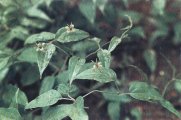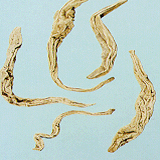Stemona Root
http://www.100md.com
《e Natural Health Center》
 |
 |
 |
Herbs for Relieving Cough and Asthma
Stemona Root
Latin:
Radix Stemonae
Origin:
The root of Stemona sessilifolia (Miq.) Miq. (sessile stemona), Stemona japonica (Bl.) Miq. (Japanese stemona) or Stemona tuberosa Lour. (tuber stemona), a perennial plant of the family Stemonaceae.
, http://www.100md.com
In China, this plant is mainly produced in the provinces Anhui, Jiangsu, Hubei, Henan, Fujian, Zhejiang, Shandong, etc. Harvested in spring or autumn, the fibrous roots are removed from the root, with the root washed clean, scalded in boiling water for a while or steamed until it has no white core, taken out, dried in the sun and cut into thick slices for use when raw or after being fried with honey.
Properties:
, 百拇医药 Sweet and bitter in flavor, slightly warm in nature, it is related to the lung channel.
Functions:
Moisturizes the lungs to arrest coughing and destroys parasites.
Applications:
1. Treats new and old coughs, pertussis and coughs of pulmonary tuberculosis:
Being so sweet as to be moistening, so bitter as to be lowering and slightly warm but not dry, this herb has special function in moisturizing the lungs to arrest coughing and it can be used for internal injuries with serious affection by exopathogens and violent coughs. It can be used alone or in combination with other herbs.
, 百拇医药
a) Coughs due to wind-cold:
This herb is used in combination with jingjie (Herba Schizonepetae), balloon flower root (Radix Platycodi), tatarian aster root (Radix Asteris), etc., e.g., Zhisou San.
b) Incessant prolonged coughs due to deficiency of both qi and yin:
This herb is used in combination with milk vetch root (Radix Astragali seu Hedysari), straight ladybell root (Radix Adenophorae Strictae), ophiopogon root, etc., e.g., Baibu Tang.
, 百拇医药
c) Coughs of pulmonary tuberculosis due to yin deficiency:
This herb is used in combination with straight ladybell root (Radix Adenophorae Strictae), ophiopogon root, tendrilleaf fritillary bulb (Radix Fritillariae Cirrhosae), etc.
d) Pulmonary tuberculosis:
In modern times, this herb has been used as the major one in combination with skullcap root (Radix Scutellariae) and red-rooted salvia root (Radix Salviae Miltiorrhizae) for the treatment of pulmonary tuberculosis, resulting certain effects on the negative-turning of phlegm bacteria and the absorption of focuses.
, 百拇医药
e) Pertussis:
This herb can be used alone or in combination with thunberg fritillary bulb (Bulbus Fritillariae Thunbergii), tatarian aster root (Radix Asteris), swallowwort root and rhizome (Radix et Rhizoma Cynanchi Vincetoxici), etc..
2. Treats oxyuriasis (small, thread-like worm that is responsible for intestinal infection in humans), trichomonas vaginalis (a species of trichomonas that produces a refractory vaginal discharge in females), head lice, scabies and tineae (fungal diseases of the skin), etc.:
, 百拇医药
This herb can destroy parasites and can get in touch with an insecticide.
a) Oxyuriasis:
Decoct this herb until thick for retention-enema before going to bed.
b) Trichomonas vaginalis:
This herb can be decocted alone or in combination with shechuangzi (Fructus Cnidii), flavescent sophora root, etc., for hip bath or external rinsing.
, 百拇医药
c) Head lice, body lice and scabies and tineae:
This herb can be made into 20% alcohol solution or 50% water decoction for external rubbing.
Dosage and Administration:
5-10 g.
Decoct this herb for oral administration.
Use an adequate amount externally.
It should be used after being fried with honey to treat prolonged coughs or coughs of deficiency type.
, 百拇医药
Cautions on Use:
Reference Materials:
'Other Medical Records of Famous Physicians' :
"Coughs and abnormal rising of qi."
'Classified Materia Medica' :
"Treats coughs and expelling lice."
'Ri Huazi's Materia Medica' :
"Infantile malnutrition with ascariasis and tuberculosis with hectic fever due to yin-deficiency."
, http://www.100md.com
'On Properties of Herbs' :
"Fever due to the lung-heat and coughs and dyspnea with adverse rising of qi."
"Moisturizing and reinforcing the lungs."
Toxic or Side Effects:
Modern Researches:
This herb contains a variety of alkaloids such as stemonine, stemonidine, protostemonine, hypostemonine, sessilistemonine, tuberostemonine, stemonanine, etc. It also contains saccharides, esters, proteins, amber, etc.
, 百拇医药
The steminine has a central antitussive (suppresses coughing) effect and it can relax the isolated animal bronchial smooth muscle affected by histamine. The water decoction and alcohol infusion of this herb have obvious killing effects on head lice and the like, oxyurids, etc. They can also reduce the pathogenicity of Asian influenza A virus on animals and they also have certain therapeutic effects on the patients affected by this virus.
The water decoction and alcohol infusion of this herb can inhibit Mycobacterium tuberculosis hominis and, in addition, inhibit a variety of cocci, bacilli and dermatomyces., 百拇医药